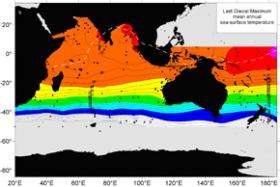New Ice Age maps point to climate change patterns

(PhysOrg.com) -- New climate maps of the Earth’s surface during the height of the last Ice Age support predictions that northern Australia will become wetter and southern Australia drier due to climate change.
An international consortium of scientists from 11 countries has produced the maps, which appear in this week’s issue of Nature Geoscience.
Dr Timothy Barrows of the Research School of Earth Sciences at The Australian National University was responsible for the Australian sector of the reconstruction.
“During the last Ice Age - around 20,000 years ago - sea surface temperature was as much as 10 degrees colder than present and icebergs would have been regular visitors to the southern coastline of Australia,” Dr Barrows said.
The temperature was estimated by measuring changes in abundance of tiny plankton fossils preserved on the sea floor, together with chemical analyses of the sediment itself.
“One of our major findings was that the continent’s mid latitudes (Canberra, Perth, Adelaide, Melbourne and Sydney) are very sensitive and experience the greatest climate change in and out of Ice Ages. This is where we should focus monitoring and look at past impacts of climate change.
“In contrast, the tropical areas (north of Brisbane) change very little, mostly less than 2 degrees.”
The global warming at the end of the last Ice Age was the greatest in recent geological history. Temperatures warmed by as much as 6-10 degrees across Australia.
‘We expect that the same pattern of change will hold for future global warming, with the temperate latitudes changing the most and the tropics changing the least,” Dr Barrows said. “It should be wetter in the tropics and drier in the south as climate belts shift.”
“Recently we have found that right at the end of the last Ice Age, temperatures were actually warmer than they are now in the southwest Pacific Ocean. We still do not know the reason for this.
“The study highlights how important researching past climate change is to understanding patterns of modern climate change. It’s crucial that Australia commit more resources so we can continue this vital work.”
Provided by Australian National University




















